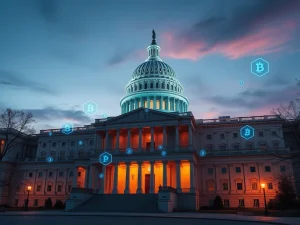Stablecoins: Wall Street Giants Unleash Transformative Crypto Payments

Once seen as a niche tool for crypto traders, stablecoins are now at the forefront of a monumental shift in global finance. Major financial institutions, including titans like JPMorgan, Citigroup, and Bank of America, are not just observing but actively investing in the development and integration of stablecoins. This signals a future where these digital assets could handle trillions of dollars in transactions, fundamentally reshaping how money moves. The landscape of crypto payments is evolving rapidly, with Wall Street leading the charge, hinting at an unprecedented convergence of traditional finance and the decentralized world.
Wall Street’s Bold Move into Stablecoins
The latest earnings season offered more than just financial reports; it revealed a significant pivot by traditional financial powerhouses towards digital currencies. Wall Street is no longer on the sidelines. During JPMorgan’s earnings call, CEO Jamie Dimon articulated the bank’s intent to be deeply involved with stablecoins, emphasizing the necessity to stay competitive in a rapidly evolving financial environment. This sentiment was echoed by Citigroup CEO Jane Fraser, who announced the bank’s exploration into issuing a ‘Citi stablecoin,’ marking a clear and strategic step into the digital asset space.
Perhaps the most detailed exploration comes from Bank of America. They have been researching fiat-pegged tokens throughout 2025, with CEO Brian Moynihan confirming during their second-quarter earnings call that stablecoins are under serious consideration. Their aim? To modernize the bank’s payment infrastructure, potentially supporting the daily movement of trillions of dollars in client assets. This commitment from institutions like JPMorgan, Citigroup, and Bank of America underscores the immense potential they see in stablecoin technology to revolutionize cross-border payments and corporate treasuries.
The Rise of Regulated Digital Assets: Paxos and OKX
Beyond the established giants, new networks are emerging to challenge the status quo, focusing on regulatory compliance and broader adoption. Crypto exchange OKX recently joined Paxos’ Global Dollar Network consortium, a move that could expose its vast user base of 60 million to the USDG stablecoin. OKX, already a hub for major stablecoins like USDT and USDC, has now enabled USDG for trading and transfers.
USDG stands out for its regulation-first approach, having registered with the Monetary Authority of Singapore and adhering to the EU’s Markets in Crypto-Assets (MiCA) framework. Its reserves are held in Singapore’s DBS Bank, offering a layer of trust and transparency. While USDG’s market share is still smaller compared to its rivals, its circulating supply has seen rapid growth, reaching $350 million over the past year. This demonstrates a clear demand for well-regulated digital assets that can operate within existing financial frameworks, paving the way for broader institutional adoption.
Bitcoin’s Enduring Dominance: A Market Analysis
While Wall Street turns its attention to stablecoins, it’s crucial to put traditional market performance into perspective against the backdrop of the crypto market. The S&P 500 Index recently hit a new all-time high, showcasing a strong recovery. However, when measured against Bitcoin, the narrative changes dramatically. Bitcoin continues to demonstrate its long-term dominance as the fastest-growing asset.
| Metric | S&P 500 (USD) | S&P 500 (Priced in Bitcoin) | Bitcoin (USD) |
|---|---|---|---|
| Year-to-Date Gains | +6% | -15% | Surging (exact % not stated, but significant) |
| Performance Since 2012 | Significant Gains | -99.98% | Exponential Growth |
As the table illustrates, despite its recent highs, the S&P 500 has lost a staggering 99.98% of its value when priced in Bitcoin since 2012. Bitcoin’s surge past $123,000 this week, fueled by booming ETF demand and speculation about supportive policy from Washington, reinforces its position as a powerhouse asset. This comparison highlights why many investors are increasingly looking towards digital assets for long-term growth and portfolio diversification.
California’s Crypto Embrace: Paving the Way for Future Crypto Payments
The innovation isn’t limited to financial institutions; governments are also recognizing the potential of blockchain and crypto. The State of California has launched the Breakthrough Project, an initiative aimed at streamlining government operations and enhancing public services. What makes this particularly noteworthy is the direct involvement of top executives from leading crypto and tech firms, including Ripple, Coinbase, and MoonPay.
This collaboration, unveiled by Governor Gavin Newsom, aims to foster closer ties between lawmakers and industry leaders. By tapping into the expertise of these companies, California seeks to drive innovation across public services and digital infrastructure, potentially revolutionizing how citizens interact with government services. This proactive stance from a major state like California could set a precedent for how governments globally approach integrating blockchain technology and facilitating seamless crypto payments and interactions.
The Future is Digital: A Compelling Summary
The trajectory is clear: stablecoins and other digital assets are rapidly moving from the fringes to the core of global finance. Wall Street’s giants are not merely experimenting; they are actively building the infrastructure for a future where digital currencies underpin vast financial transactions. From JPMorgan’s strategic intent to California’s government embracing crypto expertise, the signs point to an undeniable shift. As Bitcoin continues to outperform traditional markets, and regulated digital assets gain traction, the era of widespread crypto adoption is not just a possibility, but an accelerating reality. The financial world is undergoing a profound transformation, and stablecoins are poised to play a pivotal role in this exciting new chapter.









